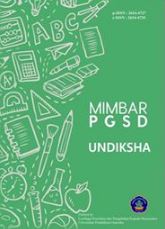Preparedness School Citizens of State Elementary School in Facing Flood through Digital Literation
DOI:
https://doi.org/10.23887/jjpgsd.v11i1.51825Keywords:
flood, disaster, digital literationAbstract
Literation serves as an important factor in education and learning process at school so that the community obtains ability in surviving at any disaster risks. This research aims to analyze the preparedness of school citizens of State Elementary School in facing Flood by Digital Literation. This research used a qualitative approach with data collection technique was used to observation, documentation and in-depth interview with school citizens. The subject of this study was school citizen of state elementary school 05 Bidara Cina included a student class 4th grade and 5th grade, teacher, principle, and vice principle. This research using primer data through LIPI/UNSECO, and secondary data was collecting the information. Results of this study found that the school has not yet used social media as a material to disclose information of knowledge on flood. Integrated information about disaster in this school still restrictiveness through Whatsapp. Based on interview results with headmaster, vice headmaster, teachers and 3 students still lack of literacy digital. It can be showed that school did not provide media information about disaster in their school or through school website. It is important to enhance preparedness of digital literacy in prone area so that school are able to take advantage of digital media to get informatioan about flood disaster and also quickly inform school community to prepared for disaster.
References
Adiputra, W. M. (2008). Literasi media dan interpretasi atas bencana. Jurnal Ilmu Sosial Dan Ilmu Politik, 11(3), 357–378. https://doi.org/10.22146/jsp.10992.
Almukarramah, Fadhillah, & Sudrajat, A. (2019). Integrasi Konsep Kebencanaan dalam Implementasi Kurikulum 2013 di Sekolah Dasar. Primary Education Journal, 10(2), 118–130. http://journal.unj.ac.id/unj/index.php/jpd/article/view/13439. DOI: https://doi.org/10.21009/jpd.v10i2.13439
Anwar, Y., & Ningrum, M. V. R. (2022). Dampak Bencana Banjir Terhadap Ekonomi Masyarakat di Kecamatan Samarinda Utara, Kota Samarinda. ,). JPG (Jurnal Pendidikan Geografi), 9(1). https://doi.org/10.20527/jpg.v9i1.12457. DOI: https://doi.org/10.20527/jpg.v9i1.12457
Aprilin, H. (2018). Kesiapsiagaan Sekolah Terhadap Potensi Bencana Banjir Di Sdn Gebangmalang Kecamatan Mojoanyar Kabupaten Mojokerto. Jurnal Biosains Pascasarjana, 20(2), 133–145. https://doi.org/10.20473/jbp.v20i2.2018.133-145. DOI: https://doi.org/10.20473/jbp.v20i2.2018.133-145
Ardales, G. Y., Espaldon, M. V., Lasco, R. D., Quimbo, A. T., & Zamora, O. B. (2016). Occurrence of Floods and Impacts on Public Schools in Los Banos and Bay, Laguna, Philippines. Journal of Nature Studies, 15(1), 19–40. https://www.researchgate.net/profile/maria-victoria-espaldon-2/publication/320490757_impacts_of_floods_on_public_schools_in_the_municipalities_of_los_banos_and_bay_laguna_philippines/links/5d7869fb4585151ee4ae00a7/impacts-of-floods-on-public-schools-in-the-municipalities-of-los-banos-and-bay-laguna-philippines.pdf.
Brown, L. M., Haun, J. N., & Peterson, L. (2014). A proposed disaster literacy model. Disaster Medicine and Public Health Preparedness, 8(3), 267–275. https://doi.org//10.1017/dmp.2014.43. DOI: https://doi.org/10.1017/dmp.2014.43
Danianti, R. P., & Sariffuddin, S. (2015). Tingkat kerentanan masyarakat terhadap bencana banjir di Perumnas Tlogosari, Kota Semarang. Jurnal Pengembangan Kota, 3(2), 90–99. https://doi.org/10.14710/jpk.3.2.90-99. DOI: https://doi.org/10.14710/jpk.3.2.90-99
Deasy, A. (2017). Dampak Bencana Banjir Terhadap Kondisi Sosial Ekonomi Masyarakat Di Kecamatan Batu Benawa Kabupaten Hulu Sungai Tengah, Kalimantan Selatan. JPG (Jurnal Pendidikan Geografi), 4(4), 42–52. http://eprints.ulm.ac.id/1980/.
Dewi, R. A. K., & Fatkhiyani, K. (2021). Blended Learning: Can It Be a Solution to Improve Digital Literacy and HOTS for PGSD Students in a Pandemic Situation? International Journal of Elementary Education, 5(4), 601. https://doi.org/10.23887/ijee.v5i4.39411. DOI: https://doi.org/10.23887/ijee.v5i4.39411
Dewi, R. K., Wardani, S., Wijayati, N., & Sumarni, W. (2019). Demand of ICT-based chemistry learning media in the disruptive era. International Journal of Evaluation and Research in Education, 9(2), 265–270. https://doi.org/10.11591/ijere.v8i2.17107. DOI: https://doi.org/10.11591/ijere.v8i2.17107
Everest., D. L. &. (2020). Guidance Notes. Spon’s Civil Engineering and Highway Works Price Book 2004.
Ferianto, K., & Hidayati, U. N. (2019). Efektifitas Pelatihan Penanggulangan Bencana Dengan Metode Simulasi Terhadap Perilaku Kesiapsiagaan Bencana Banjir Pada Siswa Sman 2 Tuban. Jurnal Kesehatan Mesencephalon, 5(2). https://doi.org/10.36053/mesencephalon.v5i2.110. DOI: https://doi.org/10.36053/mesencephalon.v5i2.110
Findayani, A. (2018). Kesiap siagaan masyarakat dalam penanggulangan banjir di Kota Semarang. Jurnal Geografi: Media Informasi Pengembangan Dan Profesi Kegeografian, 12(1), 102–114. https://journal.unnes.ac.id/nju/index.php/JG/article/download/8019/5561.
Harjono, H. S. (2019). Literasi Digital: Prospek dan Implikasinya dalam Pembelajaran Bahasa. Pena : Education Journal of Language and Literature, 8(1), 1–7. https://doi.org/10.22437/pena.v8i1.6706. DOI: https://doi.org/10.22437/pena.v8i1.6706
Islam, R., Kamaruddin, R., Ahmad, S. A., Jan, S., & Anuar, A. R. (2016). A review on mechanism of flood disaster management in Asia. International Review of Management and Marketing, 6(1), 29–52. https://dergipark.org.tr/en/pub/irmm/issue/32106/355872.
Juhadi & Herlina, M. (2020). Pendidikan Literasi Mitigasi Bencana Di Sekolah. Parist Penerbit.
Kesumaningtyas, A. M., Hafida, S. H. N., & Musiyam, M. (2022). Analysis of disaster literacy on student behavioral responses in efforts to reduce earthquake disaster risk at SMA Negeri 1 Klaten. IOP Conference Series: Earth and Environmental Science, 986(1). https://doi.org/10.1088/1755-1315/986/1/012013. DOI: https://doi.org/10.1088/1755-1315/986/1/012013
Konstantinidou, E., & Scherer, R. (2022). Teaching with technology: A large-scale, international, and multilevel study of the roles of teacher and school characteristics. Computers & Education, 179, 104424. https://doi.org/https://doi.org/10.1016/j.compedu.2021.104424. DOI: https://doi.org/10.1016/j.compedu.2021.104424
Kulju, P., Kupiainen, R., Wiseman, A. M., Jyrkiäinen, A., Koskinen-Sinisalo, K.-L., & Mäkinen, M. (2018). A Review of Multiliteracies Pedagogy in Primary Classrooms. Language and Literacy, 20(2), 80–101. https://doi.org/10.20360/langandlit29333. DOI: https://doi.org/10.20360/langandlit29333
Lassa, J., Petal, M., & Surjan, A. (2022). Understanding the impacts of floods on learning quality, school facilities, and educational recovery in Indonesia. Disasters, 7(3). https://doi.org/10.1111/disa.12543. DOI: https://doi.org/10.1111/disa.12543
Lestari, P., Paripurno, E. T., Surbakti, H., & Pratama, D. M. (2021). Model Komunikasi dan Informasi Terpadu dalam Pengelolaan Bencana di Kabupaten Karo Berbasis Web. Jurnal Komunikasi, 16(1), 47–62. http://eprints.upnyk.ac.id/27639/. DOI: https://doi.org/10.20885/komunikasi.vol16.iss1.art4
Marlyono, S. G. (2016). Peranan Literasi Informasi Bencana terhadap Kesiapsiagaan Bencana Masyarakat Jawa Barat. Jurnal Geografi Gea, 16(2), 116–123. https://doi.org/10.17509/gea.v16i2.4491. DOI: https://doi.org/10.17509/gea.v16i2.4491
Muzani, S. C., Zid, M., & Akmal, F. M. (2020). Analysis Preparedness Level of the High School Community in Facing Earthquake and Tsunami in Lebak Regency of Banten Province. IOP Conference Series: Earth and Environmental Science, 412(1). https://doi.org/10.1088/1755-1315/412/1/012014. DOI: https://doi.org/10.1088/1755-1315/412/1/012014
Ramadhan, S., Sukma, E., & Indriyani, V. (2019). Environmental education and disaster mitigation through language learning. IOP Conference Series: Earth and Environmental Science, 314(1), 0–9. https://doi.org/10.1088/1755-1315/314/1/012054. DOI: https://doi.org/10.1088/1755-1315/314/1/012054
Rizaldi, D. R., Nurhayati, E., & Fatimah, Z. (2020). The Correlation of Digital Literation and STEM Integration to Improve Indonesian Students’ Skills in 21st Century. International Journal of Asian Education, 1(2), 73–80. https://doi.org/10.46966/ijae.v1i2.36. DOI: https://doi.org/10.46966/ijae.v1i2.36
Setiyadi, R., Kuswendi, U., & Ristiana, M. G. (2019). Digital Literation Through Online Magazine in Learning Reading Comprehension in Elementary School. PrimaryEdu-Journal of Primary Education, 3(2), 97–106. https://doi.org/https://doi.org/10.22460/pej.v3i2.1426. DOI: https://doi.org/10.22460/pej.v3i2.1426
Setyaningsih, R., Abdullah, A., Prihantoro, E., & Hustinawaty, H. (2019). Model Penguatan Literasi Digital Melalui Pemanfaatan E-Learning. ASPIKOM Journal, 3(6), 1200. https://doi.org/10.24329/aspikom.v3i6.333. DOI: https://doi.org/10.24329/aspikom.v3i6.333
Syarif, A., Unde, A. A., & Asrul, L. (2014). Pentingnya komunikasi dan informasi pada implementasi kebijakan penyelenggaraan penanggulangan bencana di kota Makasar. Jurnal Komunikasi KAREBA, 3(3), 142–152. https://doi.org/10.31947/kjik.v3i3.583.
Tingsanchali, T. (2012). Urban flood disaster management. Procedia Engineering, 32, 25–37. https://doi.org/10.1016/j.proeng.2012.01.1233. DOI: https://doi.org/10.1016/j.proeng.2012.01.1233
Yustika, G. P., & Iswati, S. (2020). Digital Literacy in Formal Online Education: A Short Review. Dinamika Pendidikan, 15(1), 66–76. https://doi.org/10.15294/dp.v15i1.23779. DOI: https://doi.org/10.15294/dp.v15i1.23779
Downloads
Published
How to Cite
Issue
Section
License
Copyright (c) 2023 Nikita Theresia Afdan, E Nugrahaeni, Cahyadi Setiawan, Shalsa billa, Wahyu Wardana

This work is licensed under a Creative Commons Attribution-ShareAlike 4.0 International License.
Authors who publish with the Mimbar PGSD Undiksha agree to the following terms:
- Authors retain copyright and grant the journal the right of first publication with the work simultaneously licensed under a Creative Commons Attribution License (CC BY-SA 4.0) that allows others to share the work with an acknowledgment of the work's authorship and initial publication in this journal.
- Authors are able to enter into separate, additional contractual arrangements for the non-exclusive distribution of the journal's published version of the work (e.g., post it to an institutional repository or publish it in a book), with an acknowledgment of its initial publication in this journal.
- Authors are permitted and encouraged to post their work online (e.g., in institutional repositories or on their website) prior to and during the submission process, as it can lead to productive exchanges, as well as earlier and greater citation of published work. (See The Effect of Open Access)













